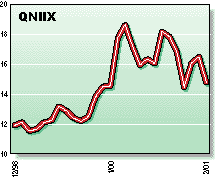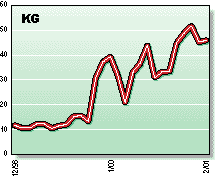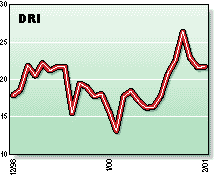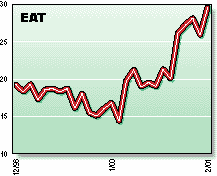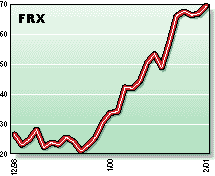
HOT TOPICS LIST
- Strategies
- Stocks
- Buy
- Investing
- Brokers
- Psychology
- Interviews
- Accumulate
- Sell
- Hold
- Spotlight
- Websites
- Candlestick Corner
- Gold & Metals
- Options Trading
LIST OF TOPICS
INTERVIEWS
Robert von Pentz of Quant Funds
04/30/01 04:56:56 PM PSTby David Penn
Robert von Pentz, portfolio manager of the Quant Mid Cap Fund, is a member of Columbia Partners and is responsible for all equity investment activities there. Before he joined Columbia Partners, von Pentz served as chairman of the board and chief investment officer of Riggs Investment Management Corporation (RIMCO). He has also held the positions of vice president and director of equity research for Maryland National Bank. At the Quant Mid Cap Fund, he specializes in adding stocks to his fund that aren't too big and aren't too small and he works to make sure that the stocks aren't what were popular last year, but represent the current market environment. Working Money Staff Writer David Penn spoke with von Pentz on March 13, 2001.
 "It's unlikely that we will have two back-to-back poor years,
Bob, how did you get interested in finance? Was finance something you were interested in from early on, or did you only become interested after you got older and started making money? I have a degree in economics, and I always had an interest in politics, government, world affairs, and how the economies fit together. Since high school, I've been fascinated with the stock market in general. My job is a great one despite all its pressures and difficulties, because I come to work every day to try to understand what's happening in the world of companies. That's what attracted me to this business, and one of the reasons I went back to get a master's degree in business administration in finance was to understand all that. How many people get paid to read three newspapers every morning? I do. I find that to be a very rewarding experience. And I'm glad I can say that, because the last few months haven't been very rewarding. I think that goes for most investors! To start off, let's talk about your fund, which is a mid-cap fund. How do you define "mid-cap"? We typically measure a company's size by the value of the outstanding shares of the company, as opposed to by how big its sales or earnings are. We tend to define mid-cap companies as those with a market capitalization of more than $2 billion and less than about $10 billion. You've mentioned elsewhere that many of the new-era technology stocks had worked their way up to a mid-cap designation they might not have deserved. In the course of what may have been a once-in-a-lifetime period, during the technology/Internet/telecommunications surge of 1999 and early 2000, companies went public even if they were small, because there was such demand for those shares. During that period, investors were willing to buy growth at any price. Relatively new and small companies abruptly became mid-sized companies because the market put such a premium on their valuations. That's why I prefaced it by saying that mid-capitalization tends to be by market size, not by sales or earnings or employees or something along those lines. This happened for a time, but obviously has been corrected by the natural equilibrating forces of the market. Smaller companies are now smaller, and medium-sized companies are still medium-sized. Do you look at revenue and earnings size when you're searching for mid-caps? Just for clarity, we look at market capitalization that's between $2 billion and $10 billion. On the purchase side of the equation, though, we are pretty rigid in buying medium-sized companies. We rarely buy a small company or a large company in the mid-cap fund. We do like to let our winners run, so sometimes a company that starts out as a mid-cap creeps beyond that magical $10 billion cutoff. When that happens, we will hold it, maybe trim back, but we'll never make as an original purchase a company that's not mid-cap or medium-sized.
A look at the performance of the
Looking at the fund's performance, I see that you were able to take advantage of some of that mid-cap, new-era growth on the way up without taking too much of a hit on the way back down. How did you accomplish that? Thank you for saying that! In this market, when things are going down, you certainly don't feel as though you've done anything right. We were reasonably fortunate in our decision to reduce our weight in the technology sector in the spring of 2000. We continued to reduce our weighting in it throughout much of the year. We did that based on valuation and what appeared to be deteriorating fundamentals. In terms of the market downturn, did the quantitative signals come first or did you start to feel uneasy as you watched the markets day after day? I was uneasy with what was happening in technology before the markets actually began to turn down. Similarly, many portfolio managers and the folks in the media were uncomfortable even in the middle of 1999 and into the first quarter of 2000, when those stocks were still going up. They were uncomfortable, subjectively, with the valuations. So that backdrop certainly existed. We've been talking about technology, but there are other sectors that have done well for the fund, financials and health care in particular. Why have you been interested in some of these sectors as places to invest outside of tech stocks? Technology has become such a big part of the underlying benchmark that when you begin to reduce your investments in that sector, you have to start investing in other sectors. If you look at some of the objective measures that have historically proved to be a reasonably good predictor of future stock price performance, you will find that it's different for different sectors. We think the financial sector is very much a value-driven sector. Valuation models help you predict stock price performance better than other variables. So in financials, for example, the stocks were attractive on a valuation basis. But they were out of favor for the better part of three years while investors focused on high-growth companies, principally technology companies.
King Pharmaceuticals (KG) markets branded |
| But once you moved away from tech stocks ... When we began to move away from technology stocks, the financial sector was a logical place to go. The earnings deterioration seemed to have stopped there, the valuation underpinning was there, and the odds favored outperformance in that sector. If you step back and look at it from a subjective angle, you will find that eight out of 10 portfolio managers say that the financial sector will do well when interest rates are falling. That certainly supported the underlying analytics to make that move. What else? We also moved some money to health care. Unusually, there has been a dichotomy, if you will, between large-cap health care, which did reasonably well but didn't have superior earnings growth rates, and some of the specialty pharmaceutical companies that had handsome growth rates. We've been overweighted in some of the specialty pharmaceutical companies based on solid earnings growth rates. You mentioned with regard to finance that the value-driven and valuation models played a significant part; with health care, you mentioned earnings growth rates increasing. Some energy stocks, oil service stocks, for example, have been in the doghouse for a long, long time. Are some of these companies starting to come back? There are two underlying drivers in the energy sector. We like to look at forward earnings growth rates and the trend in those earnings growth rates. You're correct in saying that except for a brief period in 1996 and 1997, those stocks have been out of favor for a long time. More important, there has been a dearth of oil drilling in the last several years, at least in the US.
Red Lobster and Olive Garden are among the
Chili's and Macaroni Grill are two of the So what happened there? In 2000, the demand-and-supply balance finally came into better equilibrium. We actually found ourselves short of energy supplies, which proved to be the catalyst. With higher oil prices, the oil companies were flush with cash and were planning to do more drilling. They recognized the need to replace the reserves as they pump them out. The oil services industry, which we particularly like, had consolidated significantly over the last five to seven years, meaning there were fewer players; not only that, it was more efficient and it was more market-dominant. All it took was an uptick in drilling activity or planned drilling activity to soak up the drilling or services capacity to result in what was most important for us - rising earnings forecasts and accelerating earnings growth rates. In the short run these stocks will move with the commodity price, but the ultimate driver will be whether the earnings continue to come through as forecast. There's one other sector, consumer cyclicals, in which the fund had significant weighting as of the end of 2000. Why is that? Consumer cyclicals are a big portion of the portfolio, in large part because they're a big portion of the underlying benchmark. We are very sensitive to the benchmark in that we like to keep investments in all the sectors in some approximation of the underlying benchmark weight. Our weighting of the consumer cyclical sector, like many other sectors, is bottom-up. We look at what's happening with particular companies, as opposed to any macro call. Using this kind of methodology, we find that certain kinds of companies look pretty good. Sometimes we see the theme that's playing out after the fact. We don't try to find a theme that we think works and then go out and select companies based on it. So your investments in consumer cyclicals have been company-specific? Yes. We've had some successful investments in the restaurant and discount retailing sectors - Family Dollar Stores (Fdo) and BJ's Wholesale Club (BJ), to name a couple. For this sector, it has been a bottom-up approach: Which companies are doing reasonably well? Which earnings are coming through? And where are business conditions better? It has been less of a macro call about such things as consumers and their health, whether they are going to spend, the possibility of a recession, the unemployment figures, and other macro factors. The ownership has been more stock-specific. On the subjective side, it's similar to the question you asked in financials. What drives these companies? It's the expectation that interest rates will fall and economic activity will subsequently accelerate, consumers will spend money and feel better about it, and so on. We've certainly seen interest rates come down, and I think everyone thinks they're going to come down further. That helps. That's a good backdrop for the global consumer cyclical sector, but it's not the principal decision-making variable for us. You've talked about your methodology. What does Quant Fund mean when its spokespeople talk about using a "quantitative method"? We think we can get an edge on picking stocks by using data analysis to determine the best predictors of future stock price performance. On a sector-by-sector basis, we've gone through extensive backtesting, harnessed huge databases, and made thousands and thousands of calculations to try to determine which variables - financial variables or price variables - are good predictors of future stock price. That narrows the pool of potential investments and defines the types of companies we're likely to invest in. Using this kind of approach helps us stay focused on what we think is most important and find companies that possess the characteristics we think are important to future stock price performance. Are these characteristics that you screen by esoteric indicators or are they combinations of things that people have heard of, like price-to-earnings ratios? Anyone who spends a fair amount of time on analysis would recognize most of the things we use. We look at valuation measures as predictors, whether that's price to cash flow, price to earnings, or price to sales. We look at the upward and downward trend in earnings estimate revisions. We look at things such as earnings growth rates and the change therein. We do have some more esoteric variables that measure balance sheet health and whether companies are using their balance sheets to manufacture earnings, which has been a new one for us, mostly because it's a tactic that is being used by company management. |
| Our view is that in some ways, you need to look at the variables that people use regularly. For example, investors will focus on earnings growth rates. They read about it in the papers, they read about it in magazines, they see and hear about it on television. Analysts talk about it all the time. By analyzing the data that the vast majority of investors are going to focus on in a systematic, consistent manner, we hope to get an edge. We try to have portfolios with good growth rates. We try to have a reasonable number of companies with good valuation. The variables that investors traditionally use do work most of the time. Just as a side note, one of the variables we measured extensively was the price/earnings-to-growth rate, which is probably one of the most-talked-about ratios on Wall Street. All of our work recently indicates that it has not proved to be a great predictor of stock prices, at least in the recent past, perhaps because the whole world is looking at it. In the last few years, we have used that variable much less and gone to more sector-specific modeling work. In some sectors, earnings growth rates are important and in some sectors they aren't. We work within the traditional framework, but have a consistent way to analyze and understand what works and what doesn't. When I first read about the Quant Fund, I was surprised to see that a significant amount of subjective judgment comes in from time to time. How do you balance the quantitative and fundamental approaches? The message we're trying to communicate is that there needs to be a second step. Having the data increases the odds of having a successful stock or sector, but it's important for us to take that second step to understand what's driving those earnings, since most of what we work with is earnings-related. This allows us to determine if they're sustainable, if the numbers are accurate, and if they make sense. In the last couple of years, we have spent more time focusing on company specifics by questioning the underlying numbers - questioning the underlying assumption on a subjective basis. We do this not so much to override, but to gain confidence in the data that's being published. We try to be sensitive to a changing environment in terms of what is working and what is not. The world is probably going to go through another iterative change with regulation FD? and its effect on the marketplace. Take earnings estimate revisions, for example. We've gone from the Chinese water torture to the guillotine. Information used to continuously dribble out, but now nothing dribbles out. In fact, I've been to enough conferences lately where management is afraid to do anything other than adhere to the prior guidance. That's why it's important, especially in smaller and mid-sized companies, to be alert to the quality of the data and what's happening within the companies themselves. How much of the model that you use involves timing for purchases? Do you use technical methods to determine when a stock is good for buying, for example? We've built technical measures into some of the modeling work, with relative strength the largest predictor or factor. We use it, but it doesn't necessarily enhance the day-to-day timing. Is today a better day to buy than tomorrow? Anybody who has been in the money management business for a while probably looks at a stock chart before they make a purchase or sale. Whether or not it governs their decision varies from manager to manager. But we do want to look at the stock chart and use some established techniques to determine if today is better than tomorrow to make a purchase. But technical analysis is not a major part of our thrust and method of operation. You mentioned the willingness to let winners run and not necessarily dump those stocks simply because their capitalization has grown. What are some of the exit signals built into the process you use? In many ways, it's almost the reverse of what's attractive. If positive earnings revisions and accelerating growth rates are important to a sector and important to us, the exit signal is simply the reverse, where revisions are negative and growth rates are contracting. That's why I'm not attracted to buying more high tech. I've got what I've got and I'm not particularly interested in buying much more. Similarly, in a more value-driven sector, we're keeping a sharp eye on the valuations. If undervaluation attracted us to a sector or a company, then when it becomes overvalued, we leave. I imagine readers being fascinated by all these different aspects, but maybe saying to themselves, "I can't put together a screening process to go through all these things." Do you think average or retail investors can incorporate some of the quantitative indicators you use? To be honest, no, not unless they have a lot of time. Individual investors should think about their methodology, the consistency of their approach, and discipline. It's difficult to analyze pages of data in a constant, real-time way and also do the maintenance. For example, replicating a strategy that involves moving from one sector or asset class to another when certain variables prove to be less effective can be difficult for the individual investor. What role does the current explosion of information play for the average investor? Information is ubiquitous today. In a way, it's a great time to be investing because you have access to so much information and data. The key to investing is knowing which pieces of data to use and which pieces to discard. Coming to those judgments is the key. I wouldn't want to dissuade someone from trying to use earnings growth rates and consensus forecasts and so on, because it can be done. It just requires dedication and a lot of time. What would you recommend for individuals trying to decide between mutual funds? What are some things they should look for in regard to choosing mutual funds that might use a variety of techniques - quantitative, fundamental, or even technical - for picking stocks? I think it's tougher sometimes to pick a mutual fund than it is to pick an individual stock. But the benefits of investing in a mutual fund for small amounts of money are great. I think what an investor has to look at over time is: Do the portfolio manager's methods and objectives make sense? And does it look as if the manager stuck to his basic discipline over time and have the results borne that out? |
| What do you think about expenses in equity mutual funds? Is that something individual investors should be preoccupied with, or does it depend on the performance of the fund? Expenses are probably one of the last things people should look at. Expense ratios relative to the performance of a fund are regularly published and all the monitoring groups look at it, so it's an easy statistic for investors to focus on. But I would rather pay more for performance than have a low-fee fund that sacrifices results. Investors ought to focus on the returns, how the funds have gotten to that point, and the replicability, as opposed to the fee structure. Think about it. In the average year, someone's return is going to be in double digits one way or another. It's either going to be up 10% or 15% or down 10% or 15%. The numbers are meaningful and the fee, whether it's 0.50% or 2%, is not that huge relative to the performance. I would not sacrifice a good fund and a good manager simply based on fees. You mentioned a couple of specific stocks earlier, and there were some in the fund that had done well that I was curious about. Are there any you think might be particularly worthwhile to discuss? They all have their own stories for their own reasons, but serve to illustrate our process. Let's start in the consumer area. As I said, we've focused on the restaurant group. Two medium-sized companies that I think fit a theme are Brinker International (Eat), principally known for the Chili's franchise, and Darden Restaurants (Dri), principally known for the Red Lobster franchise. What else? In the energy sector, many of the drilling-related companies look good, such as Noble Drilling (NE) and Weatherford International (Wft), one being an offshore driller and the other being more of an oil services company. They both have modest multiples with high, double-digit earnings growth rates. The intuitive argument is that gas prices are high and they'll be drilling more, so these companies are likely to benefit over the next couple of years. Anything else you're interested in? There's Forest Labs (Frx). Forest Labs is a company we've owned for a long time. It has actually gone over $10 billion and I've begun to trim back our weighting in it, so that's not one I think is a particularly great bargain today. A more recent purchase in health care is Aetna (Aet), which is in the insurance or managed-care sector - an area before now I hadn't invested in for a long time. There have been some management changes and restructuring and I'm thinking that earnings can begin to accelerate. That's an example of good valuation in a company that's been out of favor. Do you think that individual investors in general, excluding daytraders, tend to have too short a time frame when they look at stocks and mutual funds? I don't know how to answer that question. If every investor was acting the way they're being portrayed on the financial news shows on TV, then yes, I think that would be the case. But I don't think most investors think that way. To wrap up, any predictions on the markets for the rest of this year? Well, let's look at some statistical evidence. The number of back-to-back negative years in the market is very few. We had a negative year last year, certainly in the Standard & Poor's 500, although not in mid-caps. It's unlikely that we will have two back-to-back poor years, which would suggest to me that at some point the negative sentiment has to end and things have to turn. I would say that would happen before the end of this year.
Forest Laboratories (FRX) manufactures and
Financial experts being interviewed on television are now very comfortable telling investors to take the most defensive posture. People are talking about bonds and bond funds and things of that nature. That's telling you that the psychology is negative and people are getting defensive. If you take the statistical evidence that it's unusual to have two back-to-back negative years, along with the current sentiment, I think we're going to hit bottom and finally turn. What may surprise people is that it's not the former areas of leadership that will take us back up in the market. Instead, it'll be some other areas that provide the bulk of the gains over the next 18 months. Thank you for spending some time with me this afternoon, Bob. Current and past articles and interviews from Working Money, The Investors' Magazine, can be found at Working-Money.com. All securities mentioned above were held in the Quant Mid Cap Fund's portfolio as of February 28, 2001; however, there is no guarantee that the securities will continue to be viewed favorably or held in the fund's portfolio.
Copyright © 2001 Technical Analysis, Inc. All rights reserved.
|
Technical Writer for Technical Analysis of STOCKS & COMMODITIES magazine, Working-Money.com, and Traders.com Advantage.
| Title: | Traders.com Technical Writer |
| Company: | Technical Analysis, Inc. |
| Address: | 4757 California Avenue SW |
| Seattle, WA 98116 | |
| Phone # for sales: | 206 938 0570 |
| Fax: | 206 938 1307 |
| Website: | www.traders.com |
| E-mail address: | DPenn@traders.com |
Traders' Resource Links | |
| Charting the Stock Market: The Wyckoff Method -- Books | |
| Working-Money.com -- Online Trading Services | |
| Traders.com Advantage -- Online Trading Services | |
| Technical Analysis of Stocks & Commodities -- Publications and Newsletters | |
| Working Money, at Working-Money.com -- Publications and Newsletters | |
| Traders.com Advantage -- Publications and Newsletters | |
| Professional Traders Starter Kit -- Software | |
PRINT THIS ARTICLE

|

Request Information From Our Sponsors
- StockCharts.com, Inc.
- Candle Patterns
- Candlestick Charting Explained
- Intermarket Technical Analysis
- John Murphy on Chart Analysis
- John Murphy's Chart Pattern Recognition
- John Murphy's Market Message
- MurphyExplainsMarketAnalysis-Intermarket Analysis
- MurphyExplainsMarketAnalysis-Visual Analysis
- StockCharts.com
- Technical Analysis of the Financial Markets
- The Visual Investor
- VectorVest, Inc.
- Executive Premier Workshop
- One-Day Options Course
- OptionsPro
- Retirement Income Workshop
- Sure-Fire Trading Systems (VectorVest, Inc.)
- Trading as a Business Workshop
- VectorVest 7 EOD
- VectorVest 7 RealTime/IntraDay
- VectorVest AutoTester
- VectorVest Educational Services
- VectorVest OnLine
- VectorVest Options Analyzer
- VectorVest ProGraphics v6.0
- VectorVest ProTrader 7
- VectorVest RealTime Derby Tool
- VectorVest Simulator
- VectorVest Variator
- VectorVest Watchdog

